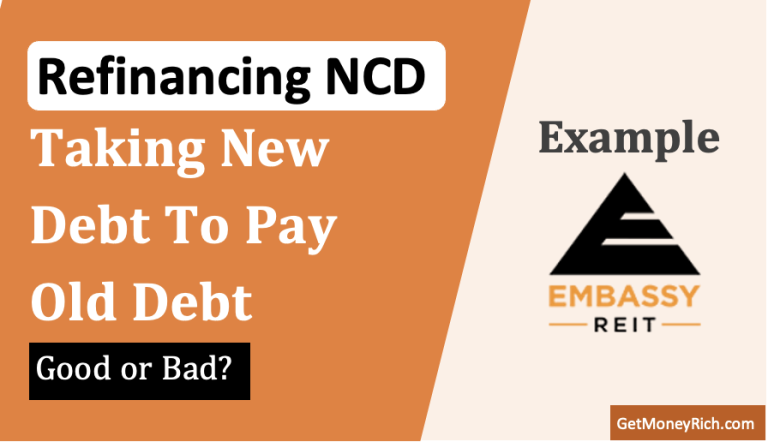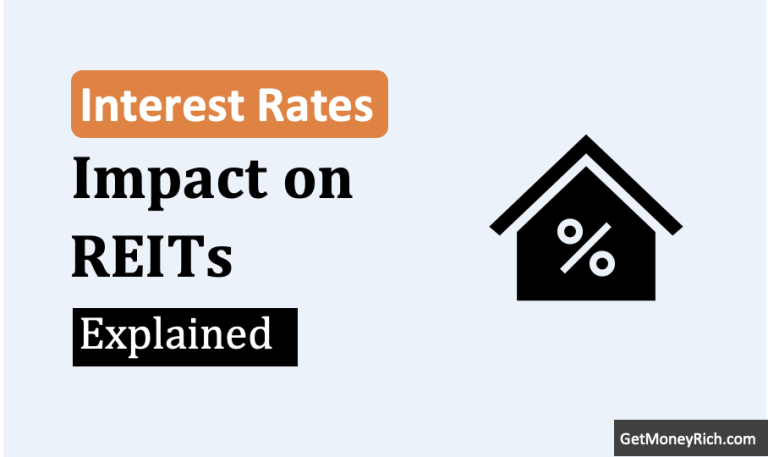Summary:
- Embassy REIT’s Rs.675 crore short-term debt to repay loans and fund working capital reflects a common corporate finance strategy, but rising debt and low interest coverage signal risks for investors to monitor.
Embassy REIT Financial Metric Calculator
Introduction
I was following the news about Embassy Office Parks REIT. I saw a related headline that that said “Embassy REIT raises Rs.675 crore short-term debt to repay existing loans, for working capital.” It sounds a bit odd, doesn’t it? Why would a company take a new loan to pay off an old one? If you’re thinking this smells like trouble, something we’re warned against in personal finance, you’re not alone. I thought the same at first. But we must remember that corporate finance doesn’t always work like our personal budgets.
Allow me to decode what this news really means for Embassy REIT.
I have also checked the last five year’s financial data of Embassy REIT to get a better perspective of the company. With information in my back pocket, let me decode for you why Embassy REIT is taking new debt to repay the old one.
Why New Debt for Old Debt Feels Like a Red Flag
When I first read about Embassy REIT’s Rs.675 crore debt, my mind went to personal finance advice we’ve all heard: “Don’t borrow to pay off debt.”
It feels like digging a deeper hole, right?
In our daily lives, taking a new loan to clear an old one often means you’re struggling to manage money. Financial gurus would call it a disaster waiting to happen.
So, it’s natural to wonder why a big companies like Embassy REIT is doing this.
Is the company in trouble? Or is there more to the story?
To answer this, we need to understand how businesses like REITs handle debt differently from you and me.
Corporate Finance Is Not Same As Personal Finance
Unlike personal finance, where debt is often a burden, companies use debt as a tool.
To understand what Embassy REIT is doing, think of it like this, when you take a home loan, you’re betting on a stable income to pay it off. For a company like Embassy REIT, debt is like fuel for growth. They own high-value office properties in cities like Bengaluru, Mumbai, Pune, etc which are often leased to top companies.
These properties generate steady rental income for the REIT, like a reliable monthly paycheck. As a rule, 90% of the REITs net profit must be distributed as dividend to REITs stock holders. So, its means, if REITs has to grow, they must rely on debt. They do not have the option of retaining more profits (like other companies) to grow.
Borrowing allows REITs to buy more properties, upgrade existing ones, or manage cash flow.
But why borrow to repay old debt?
It’s often about getting better terms, lower interest rates, longer repayment periods, or more flexibility. It’s like refinancing your home loan to save on EMI.
For Embassy, the current Rs.675 crore could be a smart move, not a sign of panic.
Let’s see if their financials back this up.
Embassy REIT’s Financial Health: The Big Picture
To understand this debt move, I decided to dig into the Embassy REIT’s financial reports (last 5 years).
The numbers that I saw tell a story of growth, but also some challenges.
- The revenue grown is decent. It has grown from Rs.2,457 crore to Rs.4,127 crore in last 5 years (at 10.9% CAGR). It shows their office spaces are in demand, likely from global firms setting up in India.
- The net profit after tax also jumped from Rs.964 crore to Rs.1,625 crore over the same period. Again, this is a growth rate of 10.9% annually.
These are strong signs that Embassy is doing well operationally.
But there is also slight negative. Their debt has grown too. Total borrowings, including short-term and long-term, went from Rs.10,602 crore in 2021 to Rs.19,807 crore in 2025. But we cannot judge the debt levels looking at the absolute values.
We must see their debt-equity ratio. The debt-equity ratio will show how much debt they have compared to their equity. In the last five years, D/E ratio has risen from from 0.39 to 0.87.
This is higher than before, but not unusual for REITs, which often use debt to expand.
The question is, can they handle this debt without trouble?
The New Rs.675 Crore Debt Makes Sense?
Let’s zoom in on the Rs.675 crore short-term debt.
The news says this new debt for two things, repaying existing loans and funding working capital.
- Repaying loans sounds like refinancing. It means, swapping old debt for new, possibly at a better rate or terms. For example, if Embassy had an older loan at 8% interest, they might replace it with one at 7.8%, saving money over time. Short-term debt are usually due within a year. They are often cheaper than long-term debts. This could be a clever way to manage cash flow while planning for bigger financing later. Read this another story of Embassy REITs using news debt to refinance its NCDs.
The working capital part is more interesting.
- Working capital is the money a company needs for day-to-day operations, like maintaining properties, paying staff, or upgrading facilities for tenants. Embassy’s balance sheet shows their current ratio, which measures their ability to pay short-term bills, dropped to a low 0.12 in 2025. That’s a red flag. Low current ratio means they don’t have enough liquid assets to cover immediate expenses.
Borrowing Rs.675 crore for working capital suggests they’re bridging a cash flow gap.
But is this a sign of weakness, or just business as usual for a REIT? Let’s dig deeper.
The REIT Business Model
For REITs, debt is their Growth Engine.
Before judging Embassy for using new debt to repay old one, we need to first understand how REITs work.
Embassy REIT owns office buildings that generate rental income. Unlike a typical company, REITs are required to distribute 90% of their cash flows to investors as dividends. This leaves little cash for growth or unexpected expenses. So, they often borrow to fund new projects or cover short-term needs.
Embassy’s cash profit margin, a measure of cash generated from operations, is a healthy 63.38% in 2025. This shows they’re producing good cash, but their working capital days is negative (-177.39). This suggests that the company is spending its cash very fast, likely on dividend distributions or property investments.
The Rs.675 crore debt fits this model.
It’s a small fraction of their total short-term borrowings (Rs.5,687.64 crore in 2025). In the last five years, the short term borrowing have grown rapidly. They might be using this loan to pay off a maturing debt or to keep operations running smoothly while waiting for rental income to roll in.
We can understand it like this, taking a small personal loan to cover expenses until your salary hits the bank.
For a company like Embassy REIT, who have a steady rental income, this kind of debt refinancing is common.
Are There Cracks in the Foundation (Risks)?
I’ll not sugarcoat things.
Embassy’s financials raise some concerns.
The biggest worry is their interest coverage ratio (ICR). This ratio shows how easily they can pay interest on their debt.
In 2025, ICR is at a scary level of 1.06, down from 2.01 in 2021.
This means their earnings (EBITDA) are just barely covering interest costs. Imagine earning Rs.100 and spending Rs.94 on loan interest. It is this kind of a situation now.
If interest rates rise or rentals dip, this could become a problem.
Their liquidity is another issue.
The current ratio of 0.12 and quick ratio of 0.32 show they’re struggling to cover short-term obligations without borrowing.
The Rs.675 crore debt, while small, adds to this pressure. Short-term loans need to be repaid or refinanced quickly, which can be risky if cash flows falter.
Plus, their operating profit margin has slipped from 75.24% in 2021 to 60.41% in 2025.
This hints at rising costs or slower rental growth, which could squeeze profits if the trend continues.
So, Is This Debt a Disaster?
This time, the answer is not so easy, its both Yes and No.
The low interest coverage and liquidity issues are warning signs.
If Embassy keeps piling on debt without boosting cash flows or cutting costs, they could hit a rough patch.
The commercial real estate market in India is booming, with demand from IT and global firms. But rising interest rates could make borrowing costlier.
As an investor, I’d want to know the terms of this new debt, interest rate, repayment timeline.
More importantly, I would like to know, whether Embassy can improve its interest coverage soon.
What Should Investors Do?
If you own Embassy REIT units, don’t panic.
Their growth story is intact, with revenue and profits climbing steadily.
The debt move isn’t a disaster, it’s a standard play for REITs. But keep your eyes open. Check their next earnings report. Their current ratio, interest coverage ratio, and debt-equity ratio should improve for sure.
If possible, investors should search for news on their occupancy rates and rental growth.
For a new investor, it is essential to see both high dividend potential against the risks of rising debt and tight liquidity.
For now, I’d hold steady but stay watchful.
Conclusion
So, is taking new debt to repay old debt a bad idea? In personal finance, maybe. But in corporate finance, it’s often a strategic choice.
Embassy REIT’s Rs.675 crore debt isn’t a sign of doom, it’s only a small piece of their financial puzzle.
Their strong growth and market leadership are reassuring. But the rising debt and weak interest coverage remind us to stay cautious.
- “Existing investors should keep a close eye on how Embassy REIT manages this debt move. In an environment where interest rates could rise increasing borrowing costs, and corporate tenants face geopolitical uncertainties, REITs face challenges. Global trade tensions, like potential tariff hikes, might pressure tenant earnings, affecting leasing demand. Yet, Embassy’s strong revenue growth shows resilience. For now, I’d wait for clearer signals, more data on their debt strategy or market trends, before making any moves. Selling the REIT now feels hasty. For REIT investors, it’s a time to watch and wait, not rush to the exit“.
Have a happy investing.



